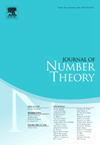New bounds in R.S. Lehman's estimates for the difference π(x)−li(x)
IF 0.7
3区 数学
Q3 MATHEMATICS
引用次数: 0
Abstract
We denote by the usual prime counting function and let the logarithmic integral of x. In 1966, R.S. Lehman came up with a new approach and an effective method for finding an upper bound where it is assured that a sign change occurs for for some value x not higher than this given bound. In this paper we provide further improvements on the error terms including an improvement upon Lehman's famous error term in his original paper. We are now able to completely eliminate the lower condition for the size-length η. For further numerical computations this enables us to establish sharper results on the positions for the sign changes. We illustrate with some numerical computations on the lowest known crossover regions near 10316 and we discuss numerically on potential crossover regions below this value.
R.S. Lehman对差值π(x)−li(x)估计的新界
我们用π(x)表示通常的素数计数函数,设li(x)为x的对数积分。1966年,R.S. Lehman提出了一种新的方法和一种有效的方法来寻找一个上界,在这个上界中,π(x) - li(x)对于某个值x不高于这个给定的上界,可以保证符号发生变化。在本文中,我们对误差项进行了进一步的改进,包括对Lehman原论文中著名的误差项S3的改进。我们现在能够完全消除尺寸长度η的较低条件。对于进一步的数值计算,这使我们能够在符号变化的位置上建立更清晰的结果。我们对10316附近已知的最低交叉区域进行了数值计算,并对低于该值的潜在交叉区域进行了数值讨论。
本文章由计算机程序翻译,如有差异,请以英文原文为准。
求助全文
约1分钟内获得全文
求助全文
来源期刊

Journal of Number Theory
数学-数学
CiteScore
1.30
自引率
14.30%
发文量
122
审稿时长
16 weeks
期刊介绍:
The Journal of Number Theory (JNT) features selected research articles that represent the broad spectrum of interest in contemporary number theory and allied areas. A valuable resource for mathematicians, the journal provides an international forum for the publication of original research in this field.
The Journal of Number Theory is encouraging submissions of quality, long articles where most or all of the technical details are included. The journal now considers and welcomes also papers in Computational Number Theory.
Starting in May 2019, JNT will have a new format with 3 sections:
JNT Prime targets (possibly very long with complete proofs) high impact papers. Articles published in this section will be granted 1 year promotional open access.
JNT General Section is for shorter papers. We particularly encourage submission from junior researchers. Every attempt will be made to expedite the review process for such submissions.
Computational JNT . This section aims to provide a forum to disseminate contributions which make significant use of computer calculations to derive novel number theoretic results. There will be an online repository where supplementary codes and data can be stored.
 求助内容:
求助内容: 应助结果提醒方式:
应助结果提醒方式:


